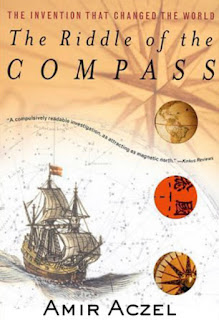"The Riddle of the Compass" by Amir D. Aczel
178 pages; Published by Harcourt, Incorporated ©2001
There are many things we use everyday that we take for granted. We don't think about how they came to be, who came up for the idea, or how people survived or accomplished their work before the invention/discovery. Amir D. Aczel's "The Riddle of the Compass" sheds light on an instrument that proved vital to trade, navigation, and other maritime duties.
"Compass" begins in the Bronze Age and immediately challenges the long-held notion that ancient sailors and navigators never let the coast out of their sights for fear of becoming lost at sea. Instead, sailors ventured far from terra firma with the aid of large statues, lighthouses, and even hiring out local fishermen whose knowledge of the waters due to their daily work proved invaluable. As time went on, ships' captains were able to sail the seas on their own with help from a little gadget that helped in big ways. A simple device that today is a basic item in Boy Scout hikes and camps.
Aczel's book follows the legend of Flavio Gioia and his importance to the small town of Amalfi, Italy. Amalfi's stature in 11th-century trade was from a combination of location and royal edicts. Today, the town that got its wealth from shipping and trade doesn't even have a harbor. Aczel explains how wealth and prosperity in shipping was attained despite modern tourists arriving by bus and not seeing a harbor necessary for ships to dock.
The compass was used by taking advantage of the earth itself. As the author acknowledges in the book's preface, "The compass works because the earth is a giant magnet." This simple connection allowed for an instrument, preceded by sounding lines, lodestones, and jade disks, to open trade routes and bring wealth to European countries. It would also pave the way for the modern GPS that is standard in many modern cars.
"The Riddle of the Compass" is a fascinating read that clues the reader into how the north, south, east, and west came to be identified. It touches on the history of Italy and the cities that found wealth through trade and shipping. Today, these Italian cities provide tourists with historical facts and legends that stem from the "bussola".



Comments
Post a Comment